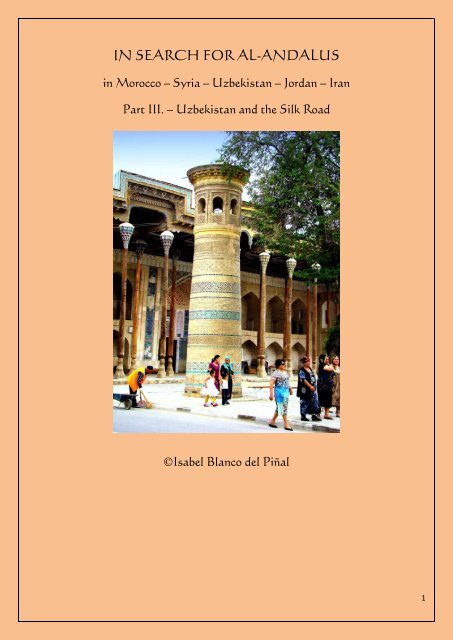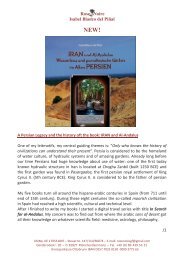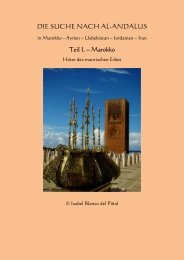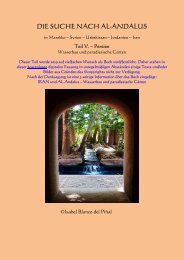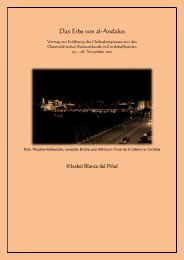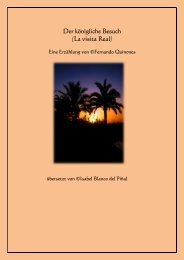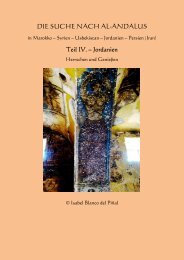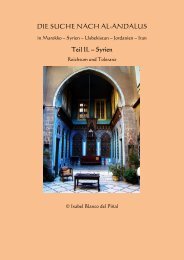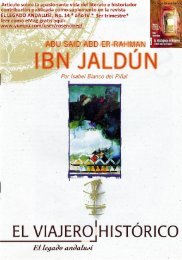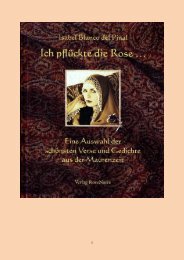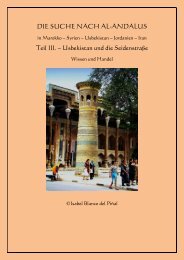IN SEARCH FOR AL-ANDALUS, Part III. - Uzbekistan and the Silk Road
The contribution shows the close relationship between the Silk Road, the ancient Uzbekistan and al-Andalus, the Medieval Muslim Spain. From 10th to 15th century al-Andalus was the country with the highest cultural, technical and scientific level in the Western World. From al-Andalus, all innovations and scientific discoveries and knowledge spread out to Medieval Europe. So, the question was: "What had the Silk Road and the old Uzbekistan to do with al-Andalus, the Muslim Spain?"
The contribution shows the close relationship between the Silk Road, the ancient Uzbekistan and al-Andalus, the Medieval Muslim Spain. From 10th to 15th century al-Andalus was the country with the highest cultural, technical and scientific level in the Western World. From al-Andalus, all innovations and scientific discoveries and knowledge spread out to Medieval Europe.
So, the question was: "What had the Silk Road and the old Uzbekistan to do with al-Andalus, the Muslim Spain?"
Create successful ePaper yourself
Turn your PDF publications into a flip-book with our unique Google optimized e-Paper software.
<strong>IN</strong> <strong>SEARCH</strong> <strong>FOR</strong> <strong>AL</strong>-AND<strong>AL</strong>US<br />
in Morocco – Syria – <strong>Uzbekistan</strong> – Jordan – Iran<br />
<strong>Part</strong> <strong>III</strong>. – <strong>Uzbekistan</strong> <strong>and</strong> <strong>the</strong> <strong>Silk</strong> <strong>Road</strong><br />
©Isabel Blanco del Piñal<br />
1
<strong>IN</strong> <strong>SEARCH</strong> OF <strong>AL</strong>-AND<strong>AL</strong>US<br />
in Morocco – Siria –<strong>Uzbekistan</strong> – Jordan – Iran<br />
©Isabel Blanco del Piñal<br />
Content of series by chapters<br />
<strong>Part</strong> I. Marokko und Al-Andalus (published, German language only)<br />
https://www.yumpu.com/de/document/view/24891541<br />
<strong>Part</strong> II. Syrien und Al-Andalus (published, German language only)<br />
https://www.yumpu.com/de/document/view/32661281<br />
<strong>Part</strong> <strong>III</strong>. Die Seidenstraße, Usbekistan und Al-Andalus (published, German language only)<br />
https://www.yumpu.com/de/document/view/22472214<br />
<strong>Part</strong> <strong>III</strong>. The <strong>Silk</strong> <strong>Road</strong>, <strong>Uzbekistan</strong> <strong>and</strong> al-Andalus (English, published)<br />
https://www.yumpu.com/en/document/view/22679226/in-search-for-al-<strong>and</strong>alus-part-iii-uzbekistan-<strong>and</strong><strong>the</strong>-silk-road<br />
<strong>Part</strong> IV. Jordanien und Al-Andalus (published, German language only)<br />
https://www.yumpu.com/de/document/view/55973636/die-suche-nach-al-<strong>and</strong>alus-teil-ivjordanien-herrschen-und-geniessen<br />
<strong>Part</strong> V. Persien und Al-Andalus (published, German language only)<br />
https://www.yumpu.com/de/document/view/62146721/die-suche-nach-al-<strong>and</strong>alus-teil-vpersien<br />
Ψ<br />
Cover picture: Mosque Holo Bauz, Bukhara/<strong>Uzbekistan</strong><br />
Remark: All o<strong>the</strong>r chapters of “In Search of al-Andalus” are only available in German language<br />
Contact: RoseNoire, Gisela Fischer <strong>and</strong> Isabel Blanco del Piñal<br />
D-81827 München/Germany – Tel. +49(89) 439 53 21 – Fax +49(89) 439 75 89<br />
Email : rosenoiregf@gmail.com all books <strong>and</strong> publications on our website: https://www.rosenoire.de<br />
All digital magazines: https://www.yumpu.com/user/rosenoiregf<br />
Facebook: https://www.facebook.com/isabel.blancodelpinal<br />
Ψ<br />
2
<strong>Uzbekistan</strong>, <strong>the</strong> <strong>Silk</strong> <strong>Road</strong> <strong>and</strong> al-Andalus<br />
Famous traditional Uzbek fabric pattern. It is<br />
used with cotton <strong>and</strong> also silk fabrics<br />
This part of my journeys "In search for al-<br />
Andalus" shows <strong>the</strong> indirect but crucial<br />
importance of <strong>the</strong> <strong>Silk</strong> <strong>Road</strong> <strong>and</strong> Old<br />
<strong>Uzbekistan</strong> as to <strong>the</strong> economic, scientific <strong>and</strong><br />
cultural splendour of al-Andalus, <strong>the</strong> Medieval<br />
Muslim Spain.<br />
The legendary trade route started in China <strong>and</strong><br />
contributed significantly to <strong>the</strong> so-called<br />
"Golden Age of Islam" (8.-13.Jh.) in all<br />
countries which were crossed by <strong>the</strong> <strong>Silk</strong> <strong>Road</strong>:<br />
historic Bactria <strong>and</strong> Sogdia (todays Nor<strong>the</strong>rn<br />
Afghanistan, <strong>the</strong> sou<strong>the</strong>rn parts of Tajikistan, <strong>Uzbekistan</strong> <strong>and</strong> Turkmenistan), Iran, Irak, Siria <strong>and</strong><br />
Istanbul. But <strong>Silk</strong> <strong>Road</strong> was not only a simple trade route for transportation of all kinds of goods.<br />
O<strong>the</strong>r, ra<strong>the</strong>r more valuable „merch<strong>and</strong>ise“ was transported along its course: breakthrough scientific<br />
inventions, trailblazing discoveries, advanced technical innovations <strong>and</strong> even religions were spread<br />
out from <strong>the</strong> Far East to <strong>the</strong> West <strong>and</strong> East thanks to <strong>the</strong> <strong>Silk</strong> <strong>Road</strong>: Buddhism came to Europe <strong>and</strong><br />
Christianism reached China.<br />
It is undisputed that <strong>the</strong> most important discoveries <strong>and</strong> innovations came mainly from China, but<br />
also from Choresmia, part of today’s Nor<strong>the</strong>rn <strong>Uzbekistan</strong>. Thanks to <strong>the</strong> excellent trade relations<br />
maintained with Arab countries all <strong>the</strong>se innovations were also transmitted without a major delay to<br />
<strong>the</strong> Muslim Spain, a l<strong>and</strong> in <strong>the</strong> extreme West of <strong>the</strong> -at that time- known world. That was how al-<br />
Andalus became <strong>the</strong> country with <strong>the</strong> highest cultural, economic, technical <strong>and</strong> scientific level in <strong>the</strong><br />
Western World. Any innovation <strong>and</strong> achievement was spread from Spain over all o<strong>the</strong>r countries of<br />
<strong>the</strong> Europe of those days. For all my journeys I had <strong>the</strong> same questions:<br />
<br />
<br />
<br />
<br />
<br />
From 8th to mid of 13th century <strong>the</strong> whole Arab world had an exceptional cultural splendor which is known<br />
as “The Golden Age of Islam”. How did al-Andalus 1 , a country located at <strong>the</strong> extreme West of <strong>the</strong> earth 2 ,<br />
reach that extraordinary level of scientific knowledge which even spread to <strong>the</strong> medieval Europe enriching<br />
<strong>and</strong> inspiring <strong>the</strong> occidental culture?<br />
During eight centuries a big part of <strong>the</strong> Peninsula had been <strong>the</strong> home country of <strong>the</strong> Hispanic Arabs. Even<br />
today <strong>the</strong> religious tolerance of al-Andalus is still famous. In fact, this tolerance only existed for few centuries<br />
in al-Andalus. In which country could I find parallels where this tolerance came from?<br />
And what about <strong>the</strong> legendary richness of al-Andalus? Until <strong>the</strong> Arab conquest 3 , <strong>the</strong> inhabitants of <strong>the</strong><br />
Iberian Peninsula grew crops, raised animals <strong>and</strong> cultivated fruits. There was a moderate textile industry<br />
based upon wool <strong>and</strong> cotton as well as mineral resources which all served to cover <strong>the</strong> personal needs.<br />
In which country would I be able to find traces of <strong>the</strong> enjoyment of life of <strong>the</strong> Umayyads, <strong>the</strong> first Muslim<br />
dynasty 4 after <strong>the</strong> death of <strong>the</strong> Prophet, in those days when Islam was young. Under <strong>the</strong> reign of <strong>the</strong> Spanish<br />
Umayyads an exotic oriental refinement was unfolded in al-Andalus, too. And last but not least: Did <strong>the</strong><br />
Muslim ban on images exist since <strong>the</strong> very first times of Islam?<br />
The Moorish Spain was famous for water works, hydraulic systems <strong>and</strong> beautiful gardens. From where did<br />
<strong>the</strong> muslim Arabs get <strong>the</strong> technical knowledge on this field?<br />
1 <strong>the</strong> Moorish Spain<br />
2 before <strong>the</strong> discovery of America<br />
3 reign of Visigoths until 711<br />
4 <strong>the</strong>ir rule lasted from 661 to 750<br />
3
What had <strong>the</strong> <strong>Silk</strong> <strong>Road</strong> <strong>and</strong> <strong>the</strong> old <strong>Uzbekistan</strong> to do with al-Andalus,<br />
<strong>the</strong> Medieval Muslim Spain?<br />
First of all let us have a look at <strong>the</strong> history of Medieval Arab Spain:<br />
Map of Muslim Spain 711-1031<br />
(dark brown=Muslim territories,<br />
light brown: Christian Kingdoms)<br />
Under <strong>the</strong> name of “Hispaniae”, Spain was part of <strong>the</strong><br />
Roman Empire from <strong>the</strong> year 201 BC until approx.<br />
415 AD. Around <strong>the</strong> beginning of 5th century <strong>the</strong><br />
Roman Empire began to decline. During <strong>the</strong>ir long<br />
history in <strong>the</strong> Near <strong>and</strong> Middle East, Romans had<br />
discovered on <strong>the</strong> riverside of Euphrates <strong>and</strong> Tigris<br />
<strong>the</strong> simple but effective Arabic water management,<br />
such as agricultural irrigation systems or how to<br />
guarantee <strong>the</strong> water supply for <strong>the</strong> cities.<br />
In those times, Spain was an extremely fertile country<br />
with moderate climatic conditions <strong>and</strong> when <strong>the</strong><br />
Arab sons of <strong>the</strong> desert concluded <strong>the</strong> conquest of<br />
Spain in 711 AD, <strong>the</strong>y believed having arrived at<br />
paradise.<br />
Once <strong>the</strong> Arab conquest concluded, only few<br />
Christian Kingdoms had survived in <strong>the</strong> extreme<br />
North of Spain. So, from 711-1031 AD most of<br />
Spanish territory was governed by Arab Emirs <strong>and</strong> Caliphs. In <strong>the</strong> beginning of 11 th century all al-Andalus was<br />
affected substantially by a civil war. After that al-Andalus disintegrated into several small kingdoms, called Taifa-<br />
Kingdoms. In 1095 until mid of 13th century, Muslim Berber dynasties from Morocco (Almoravids, Almohads)<br />
reigned over Spain.<br />
The Mosque-Ca<strong>the</strong>dral in Cordoba (Andalousia)<br />
During Muslim centuries <strong>the</strong> name of Spain was “al-<br />
Andalus” <strong>and</strong> <strong>the</strong> inhabitants were called<br />
Andalusians. Today we call <strong>the</strong> Spanish Arabs<br />
commonly <strong>the</strong> “Moors” <strong>and</strong> <strong>the</strong>ir culture, “Moorish”.<br />
Until 1031 AD all rulers of al-Andalus belonged to <strong>the</strong><br />
Umayyad dynasty. The origin <strong>and</strong> former capital of<br />
Umayyad dynasties has been Damascus. In 8 th<br />
century <strong>the</strong> Umayyad government was overthrown<br />
by <strong>the</strong> Abbasids whose capital was Baghdad.<br />
During 11 th century, Christians tried many times to<br />
reconquer <strong>the</strong> Muslim territories. But it was a hard<br />
<strong>and</strong> complicated task which required nearly<br />
unlimited resources of money <strong>and</strong> manpower.<br />
Christian rulers were always lacking both, meanwhile<br />
Andalusians had more than enough of both. Why<br />
<strong>the</strong>y had so much money <strong>and</strong> manpower – we will<br />
see that later. Most of inhabitants of al-Andalus were Muslim because also many Christians accepted to follow <strong>the</strong><br />
rules of Islam. That made life far easier. In addition, among intellectuals <strong>and</strong> young people, it became a kind of<br />
fashion to be Muslim <strong>and</strong> to wear long, flowing white garments. Today we would say it was “cool” to be Muslim.<br />
Jews had already come to Spain during Roman times, <strong>the</strong>y did not convert to Islam but all those citizens who wanted<br />
to keep <strong>the</strong>ir religious customs were allowed to do.<br />
4
The School of Translaters in Toledo/Spain (14th century)<br />
From 711 until nearly end of 11th century Arabs, Christians <strong>and</strong> Jews<br />
lived peacefully toge<strong>the</strong>r. Muslim rulers gave an utmost importance to<br />
<strong>the</strong> education of all subjects living in al-Andalus, to all kinds of Sciences,<br />
<strong>the</strong>y strongly supported <strong>the</strong> Fine Arts, <strong>the</strong> craft <strong>and</strong> weaving industries.<br />
Especially among Arabs <strong>and</strong> Jews <strong>the</strong>re were excellent craftsmen <strong>and</strong><br />
artisans for all areas. Thous<strong>and</strong>s of immigrants, craftsmen, artisans,<br />
stone masons, master builders <strong>and</strong> scientists from Mediterranean<br />
countries came to al-Andalus. The Muslim Spain was considered to be<br />
<strong>the</strong> "l<strong>and</strong> of boundless opportunities". Import <strong>and</strong> Export from <strong>and</strong> to<br />
Mediterranean countries, such as North Africa, Italy, Turkey <strong>and</strong> Arabia<br />
were strongly promoted, increasing considerably not only <strong>the</strong> richness of<br />
<strong>the</strong> rulers but at <strong>the</strong> same time, also <strong>the</strong> economic <strong>and</strong> social well-being<br />
of all citizens. One of <strong>the</strong> most important issues for <strong>the</strong> rulers were <strong>the</strong><br />
hygienic conditions <strong>and</strong> <strong>the</strong> safety in <strong>the</strong> streets of big cities: A wide<br />
network for fresh water supply same as for <strong>the</strong> discharge of dirty water<br />
was continuously amplified <strong>and</strong> improved. Just one example: In <strong>the</strong> 10 th<br />
century Córdoba was <strong>the</strong> first City in Europe to have street lamps.<br />
Since mid of 8 th century also a great part of Moroccans converted to<br />
Islam. From Morocco thous<strong>and</strong>s <strong>and</strong> thous<strong>and</strong>s Berbers were recruited<br />
to increase <strong>the</strong> Andalusian Caliphs troops. They had to defend <strong>the</strong> borders of <strong>the</strong> wide Islamic territory <strong>and</strong> were<br />
constantly on <strong>the</strong> alert. In <strong>the</strong> European <strong>and</strong> in <strong>the</strong> Arab world al-Andalus became not only <strong>the</strong> epitome for<br />
incredible richness of <strong>the</strong> rulers, for technical <strong>and</strong> scientific progressiveness in all areas, but also for religious<br />
tolerance.<br />
In <strong>the</strong> period from 12th to 13th century, most of scientific Arabic treatises were translated into Latin language at <strong>the</strong><br />
so-called School of Translaters in Toledo/Spain (in Spanish: Escuela de Traductores de Toledo).<br />
The famous courtyard of <strong>the</strong> Lions of <strong>the</strong> Moorish castle “La Alhambra”<br />
in Granada/Spain, built in 13th <strong>and</strong> 14th century.<br />
This was possible thanks to few progressive Christian scholars (among<br />
<strong>the</strong>m a French clergyman) but mainly, thanks to <strong>the</strong> Christian Spanish<br />
King Alfonso X., also called “The Wise” or “The Learned” (13th century).<br />
At that moment of history Christians had succeeded to conquer Toledo.<br />
King Alfonso X. was himself an acknowledged scientist with a huge<br />
knowledge on many fields <strong>and</strong> he had soon recognized <strong>the</strong> priceless<br />
value of <strong>the</strong> Arabic achievements. At <strong>the</strong> beginning of 12 th century,<br />
highly qualified translaters Arabs, Jews <strong>and</strong> Christians started with <strong>the</strong>ir<br />
difficult <strong>and</strong> huge task. Working h<strong>and</strong> in h<strong>and</strong> <strong>the</strong>y succeeded to transfer<br />
to Latin language all available scientific <strong>and</strong> philosophic h<strong>and</strong>written<br />
books <strong>and</strong> manuscripts containing all <strong>the</strong> knowledge of classical Arabic,<br />
Hebrew (Jewish) <strong>and</strong> also of Greek antiquity. Until that moment, all<br />
o<strong>the</strong>r European countries still had a poor cultural, technical <strong>and</strong><br />
scientific level. We can say that <strong>the</strong>se translations literally enlightened<br />
<strong>the</strong> cultural <strong>and</strong> technological “darkness” of <strong>the</strong> Medieval Europe.<br />
Ψ<br />
5
The last Moorish Kingdom in al-Andalus was <strong>the</strong> vast territory of Granada. The city itself was taken by Christian<br />
troops in January 1492. Christian kings had needed 3,5 centuries to reach <strong>the</strong>ir aim of reconquest. Granada <strong>and</strong> <strong>the</strong><br />
Moorish palace “Alhambra” will always be <strong>the</strong> symbol for <strong>the</strong> splendor <strong>and</strong>, at <strong>the</strong> same time, for <strong>the</strong> dramatic end<br />
of a sophisticated high culture. But from <strong>the</strong> end of 9th/beginning of 10th century al-Andalus was <strong>the</strong> richest<br />
European country, <strong>the</strong> country with <strong>the</strong> highest technological, cultural <strong>and</strong> scientific level in <strong>the</strong> western world. But<br />
how Andalusians did succeed to reach such a high economic <strong>and</strong> cultural level? From geographic point of view, al-<br />
Andalus was a country at <strong>the</strong> most outer end of <strong>the</strong> Western World.<br />
From where did Andalusians get <strong>the</strong> input, <strong>the</strong> impulses for all innovations <strong>and</strong> for <strong>the</strong> development of huge<br />
scientific knowledge, especially in medicine, astronomy <strong>and</strong> ma<strong>the</strong>matics?<br />
On Spice Bazaar, Aleppo/Syria<br />
The period from 8 th to mid of 13 th century is<br />
commonly called The Golden Age of Islam.<br />
Arabic culture experienced an extraordinary<br />
dynamic development <strong>and</strong> a cultural<br />
splendor. Its origin was in Orient <strong>and</strong><br />
fertilized also al-Andalus. Until <strong>the</strong> decline of<br />
Umayyad Caliphate (mid 8th century) in<br />
Arabia, <strong>the</strong> muslim Spain got most of<br />
commercial, scientific <strong>and</strong> intellectual input<br />
from Damascus (Syria) <strong>and</strong> after that, <strong>the</strong><br />
informations were transmitted from<br />
Baghdad (Abbasid dynastiy). All news <strong>and</strong>/or<br />
innovations reached Arabia through <strong>the</strong> <strong>Silk</strong><br />
<strong>Road</strong>.<br />
When caravans coming from <strong>the</strong> East arrived<br />
to <strong>the</strong> Syrian city Palmyra <strong>the</strong> hardest part of<br />
<strong>the</strong> trail was done. Palmyra was <strong>the</strong> turntable of all commerce coming <strong>and</strong> going to <strong>the</strong> West or to <strong>the</strong> East. Here <strong>the</strong><br />
<strong>Silk</strong> <strong>Road</strong> splitted up in two parts: one to <strong>the</strong> South (via Damascus along <strong>the</strong> Incense <strong>Road</strong> to Egypt <strong>and</strong> from <strong>the</strong>re to<br />
North-Africa) <strong>the</strong> o<strong>the</strong>r one to <strong>the</strong> West (via Aleppo to Turkey, <strong>the</strong>n by ship to Greece <strong>and</strong> Italy). From <strong>the</strong>re <strong>the</strong><br />
goods could be transported by l<strong>and</strong> to o<strong>the</strong>r Western countries.<br />
World map made by <strong>the</strong> Ancient Greek<br />
historian Herodot (on <strong>the</strong> right side you may<br />
see <strong>the</strong> words Sogdians <strong>and</strong> Bactra(also<br />
Bactria) 5<br />
Since <strong>the</strong> period of Sassanid dynasty<br />
(around 540 AD) transport by sea to o<strong>the</strong>r<br />
Mediterranean countries was also carried<br />
out from <strong>the</strong> Syrian port “Seleucia Pieria”<br />
(founded by a successor of Alex<strong>and</strong>er <strong>the</strong><br />
Great). From mid 8th century not only trade<br />
products, but also all kinds of scientific<br />
knowledge <strong>and</strong> technical development were<br />
transmitted from Baghdad (time of Abbasid<br />
Caliphate) to al-Andalus. Favored by its<br />
geographic location near Mediterranean<br />
countries, <strong>the</strong> Syrian cities Damascus <strong>and</strong><br />
Aleppo continued during all centuries to be <strong>the</strong> commercial hub, <strong>the</strong> marketplace for <strong>the</strong> most important oriental<br />
<strong>and</strong> Central Asian trade roads, even after <strong>the</strong> Ottoman invasion of Arabia <strong>and</strong> North Africa (Ottoman Empire: from<br />
1299 until beginning of 20th century).<br />
5 Author&source of picture: Bibi Saint-Pol, http://commons.wikimedia.org/wiki/File:Herodotus_world_map-en.svg<br />
6
The <strong>Silk</strong> <strong>Road</strong> <strong>and</strong> <strong>the</strong> Role of <strong>the</strong> Ancient <strong>Uzbekistan</strong><br />
Main Track of <strong>Silk</strong> <strong>Road</strong> from China through Central-Asia.<br />
In ancient times <strong>Uzbekistan</strong> was a part of Sogdiana (also Sogdia) 6 . Sogdiana mainly consisted in <strong>the</strong> autonomous<br />
provinces Bukhara, Samarq<strong>and</strong> <strong>and</strong> Panjakent in <strong>the</strong> Tajik province Sugd. Maybe <strong>the</strong> earliest information we have<br />
about Sogdiana comes from <strong>the</strong> ancient Greek historian Herodot (also Herodotus, approx. 484-425BC). He included<br />
Sogdiana in his (assumed) world map <strong>and</strong> in some of his works he already mentions a trade route from Far East to<br />
<strong>the</strong> Western world. Many pioneering discoveries <strong>and</strong> innovations came from <strong>the</strong> ancient China. In fact, <strong>the</strong> ancient<br />
Chinese had discovered some of <strong>the</strong> most important <strong>and</strong> progressive innovations <strong>the</strong> world had ever seen: <strong>the</strong>y<br />
discovered <strong>the</strong> papermaking, <strong>the</strong> art of silk manufacturing <strong>and</strong> how to weave precious <strong>and</strong> luxurious fabrics from <strong>the</strong><br />
threads of such noble material.<br />
The naming <strong>Silk</strong> <strong>Road</strong> is relatively young: It was <strong>the</strong> German researcher von Richthofen who, in <strong>the</strong> 19th century gave<br />
that name to one of <strong>the</strong> oldest trade routes which ever existed. But <strong>Silk</strong> <strong>Road</strong> is indeed a proper name because when<br />
trade started along that trade route, Chinese merchants paid all kind of products which <strong>the</strong>y highly appreciated<br />
(among <strong>the</strong>m, horses from Fergana Valley) with enormous quantities of silk.<br />
The <strong>Silk</strong> <strong>Road</strong> worked in both directions. Toge<strong>the</strong>r with green jade, spices from India, furs <strong>and</strong> porcelain, silk became<br />
one of <strong>the</strong> most precious merch<strong>and</strong>ise for Western civilizations, such as <strong>the</strong> ancient Greeks or Romans. Among many<br />
o<strong>the</strong>r valuable goods, Mediterranean <strong>and</strong> Arab countries provided China <strong>and</strong> India with precious stones, with<br />
incense from <strong>the</strong> Arabian Peninsula 7 , with gold, iron <strong>and</strong> glassware. The <strong>Silk</strong> <strong>Road</strong> was not at all a natural trail. From<br />
China to Fergana Valley it was an extremely hard way <strong>and</strong> <strong>the</strong> track changed according to seasons <strong>and</strong> wea<strong>the</strong>r<br />
conditions. At this point starts <strong>the</strong> role of <strong>the</strong> ancient <strong>Uzbekistan</strong> as one of <strong>the</strong> most important countries, maybe<br />
even <strong>the</strong> most important one, not only for <strong>the</strong> Far East (China, India) but for all countries located westwards from<br />
Central-Asia: Persia/Iran, Turkey, Syria as well as for <strong>the</strong> countries <strong>and</strong> cities mainly depending on medieval<br />
Mediterranean Sea trade such as North Africa, Venice in Italy <strong>and</strong> (in <strong>the</strong> extreme West) al-Andalus, <strong>the</strong> Moorish<br />
Spain. As 90% of Tajikistan consists in mountainous terrain, today’s Fergana Valley in <strong>Uzbekistan</strong> was <strong>the</strong> first fertile<br />
<strong>and</strong> flat l<strong>and</strong>scape which caravans reached after having overcome <strong>the</strong> hardest part of <strong>Silk</strong> <strong>Road</strong>: from China along<br />
<strong>the</strong> border of <strong>the</strong> desert Taklamakan crossing <strong>the</strong> pass between <strong>the</strong> mountain ranges Tien Shan <strong>and</strong> Alai. Going to or<br />
coming from India, <strong>the</strong> caravans had to cross <strong>the</strong> Khyber Pass, one of <strong>the</strong> world’s oldest mountain pass, a terribly<br />
hard trail. It was already used for <strong>the</strong>ir conquests by Alex<strong>and</strong>er <strong>the</strong> Great <strong>and</strong> his troops. Also Genghis Khan, same as<br />
all Muslim invasions of South Asia <strong>and</strong> <strong>the</strong> Turkic-Mongols came through that pass 8 .<br />
6 Please see Herodotus’ map of <strong>the</strong> World on page 6<br />
7 Incense <strong>Road</strong>: from today’s Oman to Alex<strong>and</strong>ria/Egypt <strong>and</strong> Damascus/Syria<br />
8 Source&author: user Captain Blood), http://commons.wikimedia.org/wiki/File:20050516220851!Seidenstrasse_GMT.jpg<br />
7
Courtyard of a caravanserai in Damascus. In<br />
Syria a caravanserai was called “Khan”.<br />
After having had a rest at Fergana Valley <strong>and</strong><br />
after having concluded <strong>the</strong>ir first deals,<br />
caravans continued to <strong>the</strong> more than 2.500<br />
years old Oasis-cities Samark<strong>and</strong> / Afrosiyob<br />
(also Afrasiab) <strong>and</strong> Bukhara. From Fergana<br />
Valley on, <strong>the</strong> road was easier for men <strong>and</strong><br />
<strong>the</strong>ir pack animals. Approx. each 30-40<br />
kilometers caravanserais were waiting for<br />
<strong>the</strong>m, this was <strong>the</strong> distance a caravan was<br />
supposed to cover in one day. Along <strong>the</strong><br />
complete trail, caravanserais acted as a hub<br />
for trade. The caravan leaders sold or<br />
exchanged products, people from <strong>the</strong><br />
surroundings came to buy or to offer <strong>the</strong>ir<br />
products. But caravanserais were <strong>the</strong> most<br />
important centers for <strong>the</strong> exchange of all kind<br />
of informations <strong>and</strong>/or news.<br />
Expansion of <strong>the</strong> original trade road in Sogdian<br />
times 9<br />
After Alex<strong>and</strong>er <strong>the</strong> Greats conquest (327 BC)<br />
of Sogdiana (see map Herodotus), <strong>the</strong><br />
provinces Samarq<strong>and</strong>/Afrosiyob <strong>and</strong> Bukhara<br />
organized <strong>the</strong> traffic along <strong>the</strong> <strong>Silk</strong> <strong>Road</strong>.<br />
Sogdiana was not only a province it was also a<br />
kind of commercial union of cooperation<br />
between different more or less autonomous<br />
provinces.<br />
We can compare that union somehow to <strong>the</strong><br />
very beginning of today’s European Union.<br />
That cooperation was of utmost importance<br />
because Sogdians enlarged considerably <strong>the</strong><br />
original <strong>Silk</strong> <strong>Road</strong>, creating a wide network of<br />
different trade routes from Sogdiana to <strong>the</strong><br />
East, <strong>the</strong> South <strong>and</strong> <strong>the</strong> Western World. We<br />
can say that from 2nd century BC until 10th<br />
AD, Sogdians controlled <strong>the</strong> traffic on <strong>Silk</strong><br />
<strong>Road</strong> with only few interruptions.<br />
Tthat kind of Joint venture was extraordinarily fruitful for all partners along <strong>the</strong> <strong>Silk</strong> <strong>Road</strong>. Regardless any political<br />
situation of whe<strong>the</strong>r Sogdiana belonged to Transoxiania, to Persian, Sassanid or Samanid Empires, <strong>the</strong> Sogdian Union<br />
of cooperation continued h<strong>and</strong>ling all <strong>the</strong> trade from West to Far East <strong>and</strong> back. Samarq<strong>and</strong>/Afrosiyob (Afrasiab) <strong>and</strong><br />
Bukhara became <strong>the</strong> market places for buying, selling <strong>and</strong> exchanging <strong>the</strong> most beautiful <strong>and</strong> valuable products.<br />
These cities were <strong>the</strong> gateway, a kind of open corridor to all Western countries as well as to <strong>the</strong> Far East.<br />
9 Picture: Map source+author: Liftarn, Feb. 2006) http://www.freeworldmaps.net <strong>and</strong><br />
http://commons.wikimedia.org/wiki/File:<strong>Silk</strong>routes.jpg<br />
8
Wall painting from <strong>the</strong> archeological site Afrosiyob (Samarq<strong>and</strong>).<br />
More picture information: Details of a copy of mural called The<br />
Ambassadors' Painting, found in <strong>the</strong> hall of <strong>the</strong> ruin of an<br />
aristocratic house in Afrosiyob, commissioned by King Varkhuman<br />
of Samarq<strong>and</strong> (ca. 650 AD) 10 .<br />
The archeological site Afrosiyob located on a hill just beside today’s city of Samarq<strong>and</strong> can give us an idea of <strong>the</strong><br />
radiance of that town which was inhabited at least since 250 BC. O<strong>the</strong>r sources affirm that <strong>the</strong> origin of Afrosiyob<br />
dates back to 6 th century BC. Afrosiyob was <strong>the</strong> splendorous centre of Sogdian culture, a kind of seigneurial district<br />
with manorial residences. Around 1220 Dschenghis Khan conquered that part of Samarq<strong>and</strong> <strong>and</strong> Afrosiyob was<br />
completely destroyed. However, some beautiful wall paintings survived <strong>and</strong> report from an intensive diplomatic<br />
court life. Wall paintings in that area were extremely rare.<br />
Only in <strong>the</strong> archeological site of ancient Panjakent (Tadschikistan), similar wall paintings have been discovered.<br />
Historians <strong>the</strong>refore also refer to Samarq<strong>and</strong> <strong>and</strong> Panjakent as to <strong>the</strong> Central-Asiatic Pompeii. Samarq<strong>and</strong> <strong>and</strong><br />
Bukhara were not only two of <strong>the</strong> oldest <strong>and</strong> richest cities along <strong>the</strong> <strong>Silk</strong><strong>Road</strong>, but also <strong>the</strong> places of highest<br />
intellectual <strong>and</strong> cultural level in Central-Asia. Their splendor sparkled until <strong>the</strong> decline of l<strong>and</strong> trade due to rapidly<br />
growing development of commercial maritime trade (mainly Engl<strong>and</strong>, Portugal) between approx. 15th <strong>and</strong> 18th<br />
century.<br />
Ψ<br />
10 Picture: Wikimedia Commons, Scan, Author unkown<br />
http://commons.wikimedia.org/wiki/File:Afrasiab_-_details_from_The_Ambassadors%27_Painting.JPG<br />
9
The <strong>Silk</strong> <strong>Road</strong> – Instrument for Transfer of Knowledge <strong>and</strong> Innovations<br />
But <strong>Silk</strong> <strong>Road</strong> was not only <strong>the</strong> most important trade road from Far East to <strong>the</strong> West. At those times nei<strong>the</strong>r letters<br />
<strong>and</strong> post offices, nor telephone or Internet did exist. Thus, before <strong>the</strong> discovery of paper <strong>and</strong> book printing, all over<br />
<strong>the</strong> world all kinds of news or events were transmitted from country to country through oral traditions.<br />
Fabric merchant, Samark<strong>and</strong>. Merchants<br />
display includes silk, cotton, <strong>and</strong> wool<br />
fabrics, as well as few carpets. Picture was<br />
taken between 1905 <strong>and</strong> 1915 by Sergei<br />
Prokudin-Gorsky (1863-1944) 11<br />
The <strong>Silk</strong> <strong>Road</strong> turned to be <strong>the</strong> “<strong>Road</strong> of<br />
cultural <strong>and</strong> scientific exchange”, an<br />
instrument for <strong>the</strong> transport of ideas <strong>and</strong><br />
innovations, for <strong>the</strong> transfer of scientific<br />
discoveries <strong>and</strong> new technologies. Even<br />
religions took that trail: Christian<br />
missionaries came along <strong>the</strong> <strong>Silk</strong> <strong>Road</strong> to<br />
China <strong>and</strong> Buddhist monks went from India<br />
to China <strong>and</strong> to Europe.<br />
So we can say that <strong>the</strong> Old <strong>Uzbekistan</strong> was a<br />
melting pot for all kind of cultures, a<br />
turntable not only for trade of products, but<br />
also for transfer of knowledge <strong>and</strong> technical<br />
progress from Eastern countries to <strong>the</strong><br />
Western World <strong>and</strong> back.<br />
The secret of silk production<br />
Wooden weaving- loom still in use in<br />
Morocco. In <strong>the</strong> village Bzou women<br />
continue weaving fabrics for high priced men<br />
clothing following <strong>the</strong> old Andalusian<br />
tradition of mixing silk <strong>and</strong> cotton<br />
Production of silk started in China probably<br />
5.000 years ago in <strong>the</strong> 3rd or 2nd<br />
millennium AD. It was forbidden under pain<br />
of death to takeout from China silk worms<br />
<strong>and</strong> eggs of <strong>the</strong> silk-spinner butterfly. During<br />
2.000 years <strong>the</strong> secret could be kept.<br />
According to an ancient legend, two monks<br />
were successful in “exporting” eggs <strong>and</strong> silk<br />
worms in <strong>the</strong>ir hollow walking sticks. Once<br />
<strong>the</strong> secret of silk production <strong>and</strong> <strong>the</strong> very<br />
first silk worms had succeeded to cross <strong>the</strong><br />
Chinese border towards <strong>the</strong> West,<br />
<strong>Uzbekistan</strong> was one of <strong>the</strong> very first<br />
countries to start cultivating <strong>and</strong> producing silk. Thanks to <strong>the</strong> excellent soil composition in Fergana Valley Area, <strong>the</strong><br />
mulberry trees grew nearly better here than in China.<br />
11 http://en.wikipedia.org/wiki/File:Gorskii_03948u.jpg<br />
10
Thanks to oral transmissions from traders travelling along <strong>the</strong> <strong>Silk</strong> <strong>Road</strong> to <strong>the</strong> West, <strong>the</strong> precious knowledge about<br />
silk producing <strong>and</strong> <strong>the</strong> first silk worms were brought also to Arabia. Due to its hot <strong>and</strong> dry climate, Arabia was not <strong>the</strong><br />
best place to cultivate mulberry trees, but al-Andalus was an excellent country for that purpose. Andalusian Arabs<br />
quickly learned how to produce silk <strong>and</strong> how to weave precious carpets, beautiful tapestries for <strong>the</strong> walls, pillow<br />
covers, textiles as well as all kind of robes <strong>and</strong> dresses.<br />
On <strong>the</strong> Sou<strong>the</strong>rn flank of <strong>the</strong> Andalusian mountain range Sierra Nevada, <strong>the</strong> Spanish region Alpujarra offered <strong>the</strong><br />
best climatic conditions for planting <strong>and</strong> cultivating mulberry trees. All valleys <strong>and</strong> hills in that area were covered<br />
with mulberry trees. In <strong>the</strong> Alpujarra area <strong>and</strong> around <strong>the</strong> Andalusian city of Granada <strong>the</strong>re existed thous<strong>and</strong>s of<br />
small weaving-looms, we can say that nearly even <strong>the</strong> smallest house had a weaving-loom.<br />
The Mediterranean town of Almeria (Andalusia) was <strong>the</strong> home port of <strong>the</strong> Caliphs large fleet of commercial ships.<br />
We can read in historical chronicles that in <strong>the</strong> 11th century, around 5.000 wooden-looms were counted in Almería<br />
<strong>and</strong> every week dozens of ships to all Mediterranean ports were loaded with all kinds of silkware.<br />
Even though Venice (Italy) also had a silk weaving tradition at that time, <strong>the</strong> typical Arabic oriental patterns <strong>and</strong><br />
colors were highly dem<strong>and</strong>ed not only in Arabia or North Africa but even by Christian rulers, noblemen <strong>and</strong> feudal<br />
lords. Among several o<strong>the</strong>r lucrative essential merch<strong>and</strong>ises <strong>the</strong> trade based upon silk production <strong>and</strong> weaving<br />
industry was one <strong>the</strong> main income of all rulers of al-Andalus.<br />
The Art of papermaking …<br />
Arab h<strong>and</strong>written prayer book, 18th/19th century.<br />
… also came from Far East. Traces were found that China used paper since <strong>the</strong> 2nd century BC. Before that, Chinese<br />
chroniclers wrote <strong>and</strong> even painted on silk or on tablets of bamboo. For valuable <strong>and</strong> precious manuscripts Arabs<br />
used gazelle (gazal) skin/lea<strong>the</strong>r. But that new Chinese invention marked a new era in <strong>the</strong> history of human<br />
evolution. Papermaking spread from Far East across <strong>the</strong> Western World. First it reached those countries <strong>and</strong> cities<br />
located along <strong>the</strong> <strong>Silk</strong> <strong>Road</strong> which displayed a high intellectual level, as it was <strong>the</strong> case of <strong>Uzbekistan</strong> during <strong>the</strong> socalled<br />
Golden Age of Islam in Central Asia same as in Arabic countries (9th century to 13th).<br />
Papermaking started in Samarq<strong>and</strong> <strong>and</strong> Bukhara mid 8th A.D. <strong>and</strong> end of 8th century in Baghdad. By <strong>the</strong> end of 10th<br />
beginning of 11th century it was transmitted to al-Andalus. From Spain <strong>the</strong> art of papermaking was transmitted to<br />
<strong>the</strong> rest of Europe in 13th century. A new industry was born contributing not only to a dynamic economic<br />
development but representing one of <strong>the</strong> strongest impulses to <strong>the</strong> development of Commerce <strong>and</strong> Sciences, of Fine<br />
Arts <strong>and</strong> Literature <strong>the</strong> World had ever seen.<br />
Ψ<br />
11
The Sciences: Medicine <strong>and</strong> Ma<strong>the</strong>matics<br />
Avicenna/Ibn Sina explaining human body to some students.<br />
Picture taken at Avicenna Museum, Afshona (Bukhara)<br />
Without any doubt two more sensational contributions to <strong>the</strong><br />
worldwide intellectual, technical <strong>and</strong> industrial developments are<br />
due to scientists who were born <strong>and</strong>/or partially lived in Old<br />
<strong>Uzbekistan</strong>:<br />
The first personality is <strong>the</strong> scientist Ibn Sina (in Europe: Avicenna)<br />
on <strong>the</strong> field of Medicine. Ibn Sina was born arnd. 980 AD in<br />
Afshona/Afshana (near Bukhara), he died 1037 in Hamadan<br />
(today: in Iran). In <strong>the</strong> Eastern as well as in <strong>the</strong> Western world,<br />
Ibn Sina is considered to be <strong>the</strong> fa<strong>the</strong>r of medicine. When he was<br />
born, Bukhara was <strong>the</strong> capital town of Samanid Empire. Due to<br />
<strong>the</strong> high number of scholars living <strong>and</strong> teaching in Bukhara at<br />
that time, <strong>the</strong> city was also known as Bukhara <strong>the</strong> learned or<br />
Bukhara <strong>the</strong> erudite.<br />
Ibn Sina was an exceptional allround-scientist: He wrote treatises<br />
about medicine, philosophy, astronomy, psychology, physics etc.<br />
However, his most famous works are about medicine, such as <strong>the</strong><br />
Book of Healing (philosophical <strong>and</strong> medical encyclopedia) or his<br />
Canon of Medicine (only medicine). Since <strong>the</strong> 10th century his<br />
discoveries <strong>and</strong> exact instructions about diagnosis, about use of<br />
(mainly natural) medicines, surgical techniques <strong>and</strong> healing of all<br />
kind of diseases (even cancer <strong>and</strong> eye diseases such as cataract), were applied not only in Central-Asia <strong>and</strong> Arabia,<br />
but also in al-Andalus. He was also <strong>the</strong> first to point out how important <strong>the</strong> music can be for <strong>the</strong> process of healing.<br />
In 12th century, in <strong>the</strong> Spanish town of Toledo, <strong>the</strong> Canon was also translated from Arabic into Latin language. Since<br />
<strong>the</strong>n, <strong>and</strong> until <strong>the</strong> mid of 17th century that most famous work of Ibn Sina /Avicenna in Latin language was <strong>the</strong> basic<br />
st<strong>and</strong>ard book for medicine students at all universities in Europe.<br />
Monument to al-Chuarizmi, Khiwa, 2013,<br />
<strong>Uzbekistan</strong><br />
The second world-wide famous scientist is<br />
al-Chuarizmi (also: al-Khwarizmi, al-<br />
Chwarizmi, al-Khorezmi), whose discoveries<br />
also travelled along <strong>the</strong> <strong>Silk</strong> <strong>Road</strong> until <strong>the</strong>y<br />
came to Europe.<br />
He was born around 780 AD in some<br />
(unknown) city in <strong>the</strong> wide Kingdom<br />
Khorezm (Khoresm, Khorasan), which at<br />
that time exp<strong>and</strong>ed from <strong>the</strong> counties in<br />
<strong>the</strong> North of <strong>Uzbekistan</strong> to Iran in <strong>the</strong><br />
South. He died somewhere between 835<br />
<strong>and</strong> 850 (probably near Baghdad). Very few<br />
details are known about his life. But we<br />
know that he was a scholar at <strong>the</strong> House of<br />
Wisdom (Bait/Bayt al-Hikma) in Baghdad<br />
(during Abbasid Empire).<br />
12
Page from a Latin translation of al-Chuarizmis second most<br />
important work. (Cambridge, University Library, Ii. 6.5.).<br />
Document begins with: “Dixit algorizmi…” (Thus said al-<br />
Chuarizmi…)<br />
Generally speaking, without his exceptional contribution on <strong>the</strong><br />
field of ma<strong>the</strong>matics, no technical or technological development<br />
could have been possible. Similar to Avicenna who can be<br />
considered as <strong>the</strong> fa<strong>the</strong>r of modern medicine, al-Chuarizmi’s<br />
scientific work was later on considered as <strong>the</strong> base of algebra<br />
<strong>and</strong> logarithms, although <strong>the</strong> basis for his studies <strong>and</strong> <strong>the</strong><br />
knowledge about <strong>the</strong> use of Arabic numbers had its origin in<br />
India.<br />
Thanks to his work <strong>the</strong> Arabic numerals from 1-10 were<br />
introduced in <strong>the</strong> Eastern <strong>and</strong> Western World. The word Algebra<br />
has its origin in <strong>the</strong> Arabic word al-dschabre, word included in<br />
<strong>the</strong> title of one of his most famous books: al-Kitāb al-mukhtaṣar<br />
fī ḥisāb) al-dschabre wa-l-muqābala. The word logarithm has its<br />
origin in <strong>the</strong> Latin version of his name al-gorism.<br />
Content was about arithmetics <strong>and</strong> <strong>the</strong> arabic title was probably:<br />
The Book of Addition <strong>and</strong> Substraction according to <strong>the</strong> Hindu<br />
Calculation. The first Latin translation of al-Chuarizmis<br />
ma<strong>the</strong>matic treatises was written in <strong>the</strong> School of Translaters in<br />
Toledo/Spain, probably in 12th century. These works also<br />
marked a turning point in <strong>the</strong> Western civilization. Until that<br />
moment, Roman numerals were still in use in <strong>the</strong> Western part<br />
of <strong>the</strong> World, except in al-Andalus, (Spain). The introduction of Arabic numerals in Europe was similar to a cultural<br />
revolution. The Roman Catholic Church fought a long <strong>and</strong> fierce battle against <strong>the</strong> introduction of calculation with<br />
Arabic numerals. The basis of Christian views on <strong>the</strong> world seemed to be severely shakened 12 .<br />
Ψ<br />
12 http://en.wikipedia.org/wiki/File:Dixit_algorizmi.png Page from Latin manuscript (Cambridge, University Library, Ii. 6.5.),<br />
beginning with 'DIXIT algorizmi', Baldassarre Boncompagni invented <strong>the</strong> title 'Algoritmi de numero Indorum' in 1857" Scanned<br />
from facsimile (1963). Translation probably 12th century by Adelard of Bath. PD Old.<br />
(Uploaded by user U3001, 14th June 2006, 22:39)<br />
13
And last but not at all at least, tales <strong>and</strong> Legends<br />
Storyteller on a oriental market place<br />
The <strong>Silk</strong> <strong>Road</strong> contributed not only to <strong>the</strong> richness of cities <strong>and</strong><br />
countries <strong>and</strong> to <strong>the</strong> development of technical <strong>and</strong> scientific<br />
knowledge. Since most ancient times <strong>the</strong> trade road served as a<br />
means of transportation to bring news from one edge of <strong>the</strong><br />
world to <strong>the</strong> o<strong>the</strong>r. During <strong>the</strong> evenings in <strong>the</strong> caravanserais,<br />
merchants <strong>and</strong> caravan leaders (cameleers) sat toge<strong>the</strong>r eating or<br />
having some tea <strong>and</strong> talking about what <strong>the</strong>y had seen <strong>and</strong> heard<br />
in <strong>the</strong> different cities along <strong>the</strong> trail. So, since <strong>the</strong> very first<br />
beginning of <strong>Silk</strong> <strong>Road</strong> history, <strong>the</strong> traders also transmitted tales<br />
<strong>and</strong> legends.<br />
One of <strong>the</strong> best examples for oral transmission is <strong>the</strong> marvelous<br />
collection of <strong>the</strong> Tales of <strong>the</strong> 1001 nights.<br />
Most scholars agree that <strong>the</strong> very first tales date from 3rd century<br />
<strong>and</strong> came by oral transmission probably from India. In Persia, <strong>the</strong>y<br />
became known around <strong>the</strong> year 500 AD, during Sassanid Empire.<br />
Ψ<br />
Below: 2 pages from <strong>the</strong> so-called Gall<strong>and</strong> manuscript, one of <strong>the</strong> oldest h<strong>and</strong>written edition<br />
of <strong>the</strong> 1001 Nights. Arabic manuscript dating back to <strong>the</strong> 14th century from Syria, kept at<br />
Bibliothèque Nationale, Paris 13<br />
13 http://en.wikipedia.org/wiki/File:Arabian_nights_manuscript.jpg / Author unknown.<br />
Source: http://expositions.bnf.fr/livrarab/gros_plan/mille/mille_2.htm<br />
14
Nowadays <strong>the</strong> Tales are considered to be one of <strong>the</strong> most famous fairytale books <strong>and</strong> belong to classic literature. In<br />
ancient times, <strong>the</strong> city of Samarq<strong>and</strong> must have been so famous all over Central-Asia <strong>and</strong> Far East, that <strong>the</strong> cities<br />
name is eternalized in <strong>the</strong> Tales, quite at <strong>the</strong> beginning of <strong>the</strong> Tales: One of <strong>the</strong> key persons of <strong>the</strong> frame story is<br />
Shah Zaman or Schazzenan, “Sultan (King) of Samark<strong>and</strong>” (Samarc<strong>and</strong>). He is <strong>the</strong> bro<strong>the</strong>r of Shahryar (also Shariyar,<br />
Shaharyar etc.), a fictional Persian Sassanid King who is told stories by his wife Sheherazade (also Šahrzad or<br />
Shahrzad).<br />
Upon <strong>the</strong> discovery of papermaking <strong>the</strong> Persian version was probably written down in <strong>the</strong> 9th century <strong>and</strong> was<br />
translated into Arabic language in 10th century. A book titled Fihrist of <strong>the</strong> Muslim scholar Muhammad bin Is'hāq al-<br />
Nadim is a huge Index of <strong>the</strong> books in all nations, Arabs <strong>and</strong> non-Arabs, existing in Arabic language <strong>and</strong>/or script, in<br />
every field of knowledge (appeared in 936 AD). The Tales of 1001 nights are mentioned in that Index.<br />
The earliest edition titled Arabian nights did not contain all <strong>the</strong> stories included in today’s editions. Over <strong>the</strong><br />
centuries <strong>the</strong> number of tales grew considerably, being enriched by folk tales <strong>and</strong>/or legends from different<br />
countries, mostly of Persian <strong>and</strong> Arabic origin, such as <strong>the</strong> Tale of Caliph Harun al-Rashid. O<strong>the</strong>r stories came from<br />
Egypt. Even <strong>the</strong> French author Antoine Gall<strong>and</strong> added some oriental stories at <strong>the</strong> moment when translating <strong>the</strong><br />
Tales for <strong>the</strong> first time, such as Ali Baba <strong>and</strong> <strong>the</strong> Forty Thieves. That first European edition was published 1704 in<br />
France. The Tales were translated into every global language <strong>and</strong> continue to delight all generations.<br />
<strong>Part</strong> of an Uzbek Suzani, a traditional h<strong>and</strong>icraft product. The pomegranate is symbol<br />
of good luck <strong>and</strong> fertility, same as in al-Andalus, <strong>the</strong> Moorish Spain. The name of <strong>the</strong><br />
city of Granada (Andalusia/South of Spain) comes from <strong>the</strong> Spanish word for<br />
pomegranate.<br />
Ψ<br />
15
Madrasa Nadir Devonbegi, Square Lyabi Hauz, Bukhara<br />
Conclusion<br />
A direct connection between <strong>Silk</strong> <strong>Road</strong>, <strong>Uzbekistan</strong> <strong>and</strong> al-Andalus<br />
cannot be denied. Without <strong>the</strong> <strong>Silk</strong> <strong>Road</strong>’s function as a means of<br />
transport for knowledge <strong>and</strong> discoveries, without Sogdians<br />
dynamic cooperation to strongly promote <strong>the</strong> trade on <strong>Silk</strong> <strong>Road</strong><br />
in ancient times, <strong>the</strong> cultural development of <strong>the</strong> World would<br />
have been considerably delayed.<br />
Even today, <strong>the</strong> Uzbek part of <strong>the</strong> <strong>Silk</strong> <strong>Road</strong> still fullfills part of its<br />
original purpose of transmitting <strong>and</strong> exp<strong>and</strong>ing knowledge. The<br />
Golden Age of caravan trade by <strong>Road</strong> is long past, but travelers<br />
who follow that legendary route are deeply impressed by all <strong>the</strong>y<br />
learn about its history <strong>and</strong> <strong>the</strong> splendorous cultural past of <strong>the</strong><br />
cities located along that ancient trading route. Visitors also see<br />
that <strong>the</strong> cultural, architectural <strong>and</strong> artistic heritage of <strong>the</strong> Golden<br />
Past of <strong>Silk</strong> <strong>Road</strong> was carefully restored <strong>and</strong> preserved. So I can<br />
really affirm that I found answers to some of my questions about<br />
<strong>the</strong> origins of richness <strong>and</strong> high technical <strong>and</strong> scientific level of <strong>the</strong><br />
Moorish Spain.<br />
The very first beginnings were in Central-Asia, more exactly in <strong>the</strong><br />
splendorous Uzbek cities along <strong>the</strong> <strong>Silk</strong> <strong>Road</strong> <strong>and</strong> <strong>the</strong>ir very<br />
dynamic development. In addition I found something even more precious: Through all centuries of its eventful <strong>and</strong><br />
sometimes difficult millenary history, <strong>Uzbekistan</strong> was influenced by many different civilizations. It was a melting-pot<br />
of different cultures, from Far East same as from <strong>the</strong> West. Today’s Uzbek nation, however, seems to have kept <strong>the</strong><br />
best from each <strong>and</strong> upon that base its own <strong>and</strong> very individual culture was born. I sincerely hope that even with<br />
growing tourism, <strong>Uzbekistan</strong> may keep this very own <strong>and</strong> special personality which has its roots in <strong>the</strong> countries<br />
millenary history. The irresistible flair of <strong>the</strong> country is not only due to beautiful historic buildings or to <strong>the</strong> special<br />
charm of cities like Samarq<strong>and</strong>, Bukhara or Khiva. It is <strong>the</strong> whole which makes <strong>Uzbekistan</strong> so fascinating: <strong>the</strong><br />
medieval architecture of <strong>the</strong> legendary <strong>Silk</strong> <strong>Road</strong> Cities, <strong>the</strong> millenary history of <strong>the</strong> country, to preserve religious<br />
<strong>and</strong> pious customs <strong>and</strong> showing respect for old cultural values <strong>and</strong> traditions even among young people. All that<br />
contributes that <strong>Uzbekistan</strong> continues to be a “mythical l<strong>and</strong>”, a country where visitors are enchanted by feeling <strong>the</strong><br />
magic of long past centuries, appreciating at <strong>the</strong> same time <strong>the</strong> careful approach to modern times.<br />
“Ming Rahmat O’zbekistan! – Thank you so much <strong>Uzbekistan</strong> …!”<br />
Ψ<br />
16
GESCHICHTEN AUS <strong>AL</strong>-AND<strong>AL</strong>US (3. Auflage/3rd edition)<br />
Die Königreiche Taifas, ein <strong>and</strong>alusischer Traum<br />
Isabel Blanco del Piñal<br />
Vorwort von Frau Dr. Dr. h.c. mult. Annemarie Schimmel<br />
Geschichten, Geschichte und Gedichte: Die Autorin schreibt lebendig und<br />
abwechslungsreich über Glanz und Untergang der maurischen Kultur in<br />
Spanien. Viele Jahrhunderte lang pflegten arabische Literaten und Chronisten<br />
die Tradition der, jede auch noch so winzige Kleinigkeit erfassenden,<br />
Überlieferungen. Sie verknüpften historische Fakten mit dramatischen<br />
Geschichten, mit Lyrik und Prosa jener Zeiten, mit amüsanten oder tragischen<br />
Anekdoten aus dem Leben von Königen, Dichtern, Wesiren, Philosophen oder<br />
Prinzessinnen. Ihre Chroniken bieten eine Überfülle an Informationen und<br />
enthalten auch Palastgeflüster, bösartige Intrigen, bewegende Liebesgeschichten<br />
oder Eifersuchtsdramen – zuweilen lesen sich diese Schriften wie<br />
orientalische Märchen.<br />
Isabel Blanco del Piñal hat diesen Schreibstil übernommen und lässt nicht nur die Blütezeit der maurischen<br />
Hochkultur noch einmal aufleben, die auch die abendländische Philosophie, Wissenschaft und Religion inspiriert und<br />
bereichert hat. Sie erzählt auch von dem dramatischen Untergang der spanischen Araber. Die Geschichten aus al-<br />
Andalus sind ursprünglich in drei Bänden erschienen. Bei der ersten überarbeiteten und erweiterten Neuauflage<br />
wurden sie in einem Sammelb<strong>and</strong> zusammengefasst. Die liebevoll gestaltete hochwertige Veröffentlichung erschien<br />
als Hardcover.<br />
64 Bilder in nostalgisch-braunem Duplex-Druck, 224 S. – 16x21cm, ISBN 978-3-933653-07-9<br />
Inhaltsverzeichnis und Leseprobe finden Sie auf unserer Website www.rosenoire.de.<br />
Ψ<br />
LAND AM SONNENUNTERGANG – MAROKKO<br />
Isabel Blanco del Piñal<br />
Bereits im 4. Jahrhundert n.Chr. verließen die alten Araber ihre Halbinsel, um die<br />
angrenzenden Kontinente zu erkunden. Im äußersten Westen gebot ein Furcht<br />
einflößendes und legendenumwobenes Meer ihrem Entdeckungsdrang Einhalt.<br />
„(...) Dort im Okzident beginnt das westliche Meer, das man auch das Meer der<br />
Dunkelheit nennt. Weiter darüber hinaus weiß niem<strong>and</strong>, was dort existiert (...)“<br />
schrieb der Geograph al-Idrisi im 12. Jahrhundert. Dort, am Ende des<br />
afrikanischen Erdteils, lag ein L<strong>and</strong>, das die Araber al-Maghrib al-aqsa nannten,<br />
„den äußersten Westen“ - ein L<strong>and</strong> am R<strong>and</strong>e des Sonnenuntergangs.<br />
Isabel Blanco schöpft wieder aus der reichen Fülle der überlieferten Literatur und<br />
verleiht der bewegten Geschichte des Königreichs Marokko menschliche Züge:<br />
Im L<strong>and</strong> der Berber erwachen Sultane und Poeten zu neuem Leben, heilige<br />
Männer und Geistwesen sind der Ursprung für faszinierende Legenden. Daneben<br />
lässt die Autorin auch eigene Reiseeindrücke einfließen. Große Bedeutung<br />
kommt der Epoche vom 11. bis zum 14. Jahrhundert zu in der die Schicksale von al-Maghrib und al-Andalus, dem<br />
arabischen Spanien, besonders eng mitein<strong>and</strong>er verbunden waren. Dicht an dicht sind die <strong>and</strong>alusischen Ornamente<br />
in den farbenprächtigen Teppich der marokkanischen Geschichte eingewoben.<br />
Es ist ein lebendig geschriebenes Portrait eines L<strong>and</strong>es in dem historische Zusammenhänge aufgedeckt werden und<br />
sich Vergangenheit, Traditionen und Gegenwart zu einem schillernden Mosaik zusammenfügen.<br />
Hardcover, 304 S. – 38, ganzseitige Bilder (S/W), 17x21cm<br />
ISBN 378-3-933653-06-2 – Inhaltsverzeichnis auf www.rosenoire.de<br />
17
ROSEN DER WÜSTE – Die Architektur in der arabischen Literatur<br />
von María Jesús Rubiera – Übersetzung aus dem Spanischen von Isabel Blanco<br />
del Piñal<br />
ROSEN DER WÜSTE – ein poetisches Symbol für die prunkvollen, märchenhaften<br />
Bauwerke der arabischen Architektur. Ihre Paläste und Gartenanlagen wurden<br />
aus der Wüste geboren. In der Fantasie der Beduinen verw<strong>and</strong>elten sich Hitze<br />
flimmernde Trugbilder in Türme und Kuppeln, die vor Gold und Edelsteinen<br />
glitzern, und dem erlösenden Wohlgefühl bei der Ankunft in schattigen, grünen<br />
Oasen sind üppig blühende Gärten mit leise plätschernden Wasserläufen<br />
nachempfunden. Die arabische Architektur inszenierte ein dynamisches<br />
Schauspiel, erfüllt von Licht, Farben, Klängen und Düften. Sie erschuf Bauwerke<br />
als Lustobjekte und Orte der Lust zugleich.<br />
Die Autorin gibt in diesem B<strong>and</strong> mittelalterliche Texte von arabischen Chronisten,<br />
Hofpoeten und Reisenden wieder. Sie beschreiben bis ins kleinste Detail die<br />
ehemalige Pracht von Städten, Palästen, Moscheen, Bädern und Gärten im alten<br />
Arabien und im islamischen Spanien. María Jesús Rubiera interpretiert Fakten und Legenden, jedoch ist dies keine<br />
Abh<strong>and</strong>lung über Kunst oder Archäologie. Es ist eine lange Reise durch die arabische Architektur mit weit geöffneten<br />
und verträumten Augen – ein Buch verführerischer ferner und fremder Visionen.<br />
Paperback, 256 Seiten, 20 x15cm, ISBN 978-3-93365305-5<br />
Inhaltsverzeichnis und Leseprobe auf www.rosenoire.de<br />
Ψ<br />
ICH PFLÜCKTE DIE ROSE …<br />
Eine Auswahl der schönsten Verse und Gedichte<br />
Aus der spanischen Maurenzeit<br />
Die überlieferte Lyrik in diesem B<strong>and</strong> lässt den verführerischen Zauber von al-<br />
Andalus, dem maurischen Spanien, wieder auferstehen. Sie beflügelt unsere<br />
Fantasie und erfüllt uns mit einer unbestimmten Sehnsucht, die unsere Seele<br />
wie eine sanft gezupfte Saite vibrieren lässt. Ist es unser Verlangen nach<br />
märchenhafter, schwärmerischer Romantik, nach einer heilen Welt die heute<br />
mehr denn je in fast unerreichbare Ferne gerückt scheint? Doch die Zeiten, die<br />
uns hier bewegen, waren keineswegs nur paradiesisch. Die Anthologie spiegelt<br />
auch ein Gesellschaftsbild wieder und am Ende erwartet uns, wie eine historisch<br />
logische Folge, die raue Wirklichkeit, denn der Zauber von al-Andalus zerbrach<br />
an der christlichen Rückeroberung.<br />
Isabel Blanco del Piñal führt mit Versen und Gedichten durch die Glanzzeit der<br />
maurischen Kultur bis hin zu ihrem dramatischen Untergang. Abschließend lässt sie auch zeitgenössische arabische<br />
Dichter mit ihren Klagen über den Verlust vom Paradies al-Andalus zu Wort kommen. Die Verse und Gedichte sind<br />
chronologisch nach Jahrhunderten geordnet und mit zahlreichen Erläuterungen zum Hintergrund ihrer Entstehung<br />
versehen. Hardcover, 144 S., 21x17cm, ISBN 978-3-933653-08-6<br />
Leseprobe auf www.rosenoire.de<br />
Vorwort kostenlos als PDF lesen unter: https://www.yumpu.com/user/rosenoiregf<br />
Unter dem Titel: Historische Arabesken – Die hispano-arabische-Dichtkunst<br />
18
MAURENLAND, CHRISTENLAND<br />
Ein Ritter, ein König und ein Poet: Drei Jahrhunderte spanische Reconquista<br />
Isabel Blanco del Piñal<br />
Nach den „Geschichten aus al-Andalus“, in denen Isabel Blanco del Piñal die<br />
Geschichte Spaniens von der arabischen Eroberung der Iberischen Halbinsel im<br />
Jahre 711 bis zum Untergang der maurischen Kultur im Abendl<strong>and</strong> mit der<br />
Stimme und aus der Sicht der spanischen Mauren erzählte, widmet sie in diesem<br />
B<strong>and</strong> ihre Aufmerksamkeit der Gegenseite, der spanischen Christenwelt. Drei<br />
berühmte Persönlichkeiten führen durch die drei wichtigsten Jahrhunderte<br />
zähen Ringens um die Reconquista, die christliche Rückeroberung des<br />
muslimischen Spaniens: der Ritter Rodrigo Díaz aus Vivar (11. Jh.) kurz "der Cid"<br />
genannt, König Alfons X. von Kastilien und Leon (13. Jh.), dem die Nachwelt den<br />
Beinamen „der Gelehrte“ verlieh und Miguel de Cervantes Saavedra (16./17. Jh.),<br />
der Autor des Don Quijote von der Mancha.<br />
Alle drei waren sie Grenzgänger zwischen den Religionen und Kulturen, ihr Leben<br />
und ihr Vermächtnis führen anschaulich vor Augen, wie facettenreich das Verhältnis von Christen und Mauren im<br />
damaligen Spanien bis über das Mittelalter hinaus war. Sie zeigen uns Welten politischer Grauzonen und innerer<br />
Zerrissenheit, und es wird in jedem Fall offenbar, dass nichts so war, wie es auf den ersten Blick scheint. So<br />
unterschiedlich sie von ihrem St<strong>and</strong> her waren, haben sie doch etwas gemeinsam: Mit Leidenschaft lebten sie ihre<br />
Visionen, sie verfolgten unbeirrt ihre Ziele und vollbrachten Außergewöhnliches. Und wenn auch das Leben jedes<br />
Einzelnen, aller Berühm<strong>the</strong>it zum Trotz, nicht einer gewissen Tragik entbehrt, haben ihre Werke und Taten sie doch<br />
unsterblich gemacht.<br />
Hardcover, 21x16cm, 100 Bilder in Farbe, 440 S.,ISBN 978-3-933653-09-3<br />
Inhaltsverzeichnis auf www.rosenoire.de<br />
The last critics (14. Juni 2014) for <strong>the</strong> title (in German) …:<br />
MAURENLAND, CHRISTENLAND,<br />
you find under: http://afarab.blogspot.com/2014/06/maurenl<strong>and</strong>-christenl<strong>and</strong>-rezension.html<br />
Mrs. Birgit Agada is a well-known travel journalist <strong>and</strong> also writer of own travel literature. She is specialized<br />
in Arabic <strong>and</strong> Northafrican countries <strong>and</strong> cultures.<br />
Kontakt:<br />
RoseNoire - Gisela Fischer – Isabel Blanco del Piñal<br />
Günderodestraße 20, D-81827 München (Germany)<br />
Tel. +49 (0)89 439 53 21 – Fax +49 (0)89 439 75 89<br />
e-Mail: rosenoiregf@gmail.com<br />
Webseite: www.rosenoire.de<br />
Facebook: https://www.facebook.com/isabel.blancodelpinal<br />
Alle digitalen Magazine gratis lesen: https://www.yumpu.com/user/rosenoiregf<br />
Ψ<br />
19


